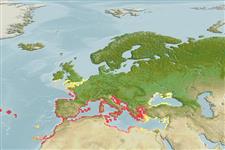Common names from other countries
Environment: milieu / climate zone / depth range / distribution range
Écologie
. Tropical; 53°N - 26°N, 32°W - 37°E
Distribution
Pays | Zones FAO | Écosystèmes | Occurrences | Introductions
Eastern Atlantic and the Mediterranean.
Length at first maturity / Taille / Poids / Âge
Maturity: Lm ? range ? - ? cm Max length : 4.0 cm CW mâle / non sexé; (Ref. 842)
Intertidal (Ref. 107021). It is found on rocks from upper to middle shore, also in crevices in breakwaters and pier piles or similar habitats (Ref. 842). Omnivore but cannot be simply considered an opportunistic feeder (Ref. 107021).
Life cycle and mating behavior
Maturité | Reproduction | Frai | Œufs | Fécondité | Larves
Members of the order Decapoda are mostly gonochoric. Mating behavior: Precopulatory courtship ritual is common (through olfactory and tactile cues); usually indirect sperm transfer.
Debelius, H. 2001. (Ref. 842)
Statut dans la liste rouge de l'IUCN (Ref. 130435)
statut CITES (Ref. 108899)
Not Evaluated
Not Evaluated
Utilisations par l'homme
Pêcheries: commercial
| FishSource |
Outils
Sources Internet
Estimates based on models
Preferred temperature
(Ref.
115969): 17.6 - 19.9, mean 18.8 (based on 394 cells).
Résilience
Haut, temps minimum de doublement de population inférieur à 15 mois (K=0.83-1.14).
Catégorie de prix
Unknown.
